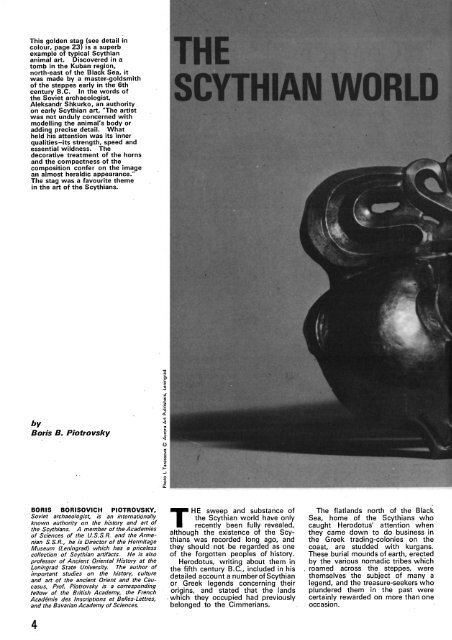The Scythians: nomad goldsmiths of the open steppes; The ...
The Scythians: nomad goldsmiths of the open steppes; The ...
The Scythians: nomad goldsmiths of the open steppes; The ...
Create successful ePaper yourself
Turn your PDF publications into a flip-book with our unique Google optimized e-Paper software.
This golden stag (see detail in<br />
colour, page 23) is a superb<br />
example <strong>of</strong> typical Scythian<br />
animal art. Discovered in a<br />
tomb in <strong>the</strong> Kuban region,<br />
north-east <strong>of</strong> <strong>the</strong> Black Sea, it<br />
was made by a master-goldsmith<br />
<strong>of</strong> <strong>the</strong> <strong>steppes</strong> early in <strong>the</strong> 6th<br />
century B.C. In <strong>the</strong> words <strong>of</strong><br />
<strong>the</strong> Soviet archaeologist,<br />
Aleksandr Shkurko, an authority<br />
on early Scythian art, "<strong>The</strong> artist<br />
was not unduly concerned with<br />
modelling <strong>the</strong> animal's body or<br />
adding precise detail. What<br />
held his attention was its inner<br />
qualitiesits strength, speed and<br />
essential wildness. <strong>The</strong><br />
decorative treatment <strong>of</strong> <strong>the</strong> horns<br />
and <strong>the</strong> compactness <strong>of</strong> <strong>the</strong><br />
composition confer on <strong>the</strong> image<br />
an almost heraldic appearance."<br />
<strong>The</strong> stag was a favourite <strong>the</strong>me<br />
in <strong>the</strong> art <strong>of</strong> <strong>the</strong> <strong>Scythians</strong>.<br />
by<br />
Boris B. Piotrovsky<br />
BORIS BORISOVICH PIOTROVSKY,<br />
Soviet archaeologist, is an Internationally<br />
known authority on <strong>the</strong> history and art <strong>of</strong><br />
<strong>the</strong> <strong>Scythians</strong>. A member <strong>of</strong> <strong>the</strong> Academies<br />
<strong>of</strong> Sciences <strong>of</strong> <strong>the</strong> U.S.S.R. and <strong>the</strong> Arme¬<br />
nian S.S.R., he is Director <strong>of</strong> <strong>the</strong> Hermitage<br />
Museum (Leningrad) which has a priceless<br />
collection <strong>of</strong> Scythian artifacts. He is also<br />
pr<strong>of</strong>essor <strong>of</strong> Ancient Oriental History at <strong>the</strong><br />
Leningrad State University. <strong>The</strong> author <strong>of</strong><br />
important studies on <strong>the</strong> history, culture<br />
and art <strong>of</strong> <strong>the</strong> ancient Orient and <strong>the</strong> Cau¬<br />
casus, Pr<strong>of</strong>. Piotrovsky is a corresponding<br />
fellow <strong>of</strong> <strong>the</strong> British Academy, <strong>the</strong> French<br />
Académie des Inscriptions et Belles-Lettres,<br />
and <strong>the</strong> Bavarian Academy <strong>of</strong> Sciences.<br />
SCYTHIAN WORLD<br />
THE sweep and substance <strong>of</strong><br />
<strong>the</strong> Scythian world have only<br />
recently been fully revealed,<br />
although <strong>the</strong> existence <strong>of</strong> <strong>the</strong> Scy¬<br />
thians was recorded long ago, and<br />
<strong>the</strong>y should not be regarded as one<br />
<strong>of</strong> <strong>the</strong> forgotten peoples <strong>of</strong> history.<br />
Herodotus, writing about <strong>the</strong>m in<br />
<strong>the</strong> fifth century B.C., included in his<br />
detailed account a number <strong>of</strong> Scythian<br />
or Greek legends concerning <strong>the</strong>ir<br />
origins, and stated that <strong>the</strong> lands<br />
which <strong>the</strong>y occupied had previously<br />
belonged to <strong>the</strong> Cimmerians.<br />
<strong>The</strong> flatlands north <strong>of</strong> <strong>the</strong> Black<br />
Sea, home <strong>of</strong> <strong>the</strong> <strong>Scythians</strong> who<br />
caught Herodotus' attention when<br />
<strong>the</strong>y came down to do business in<br />
<strong>the</strong> Greek trading-colonies on <strong>the</strong><br />
coast, are studded with kurgans.<br />
<strong>The</strong>se burial mounds <strong>of</strong> earth, erected<br />
by <strong>the</strong> various <strong>nomad</strong>ic tribes which<br />
roamed across <strong>the</strong> <strong>steppes</strong>, were<br />
<strong>the</strong>mselves <strong>the</strong> subject <strong>of</strong> many a<br />
legend, and <strong>the</strong> treasure-seekers who<br />
plundered <strong>the</strong>m in <strong>the</strong> past were<br />
certainly rewarded on more than one<br />
occasion.

















